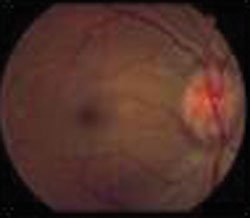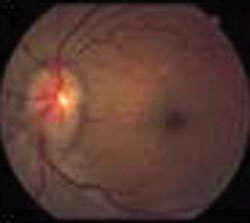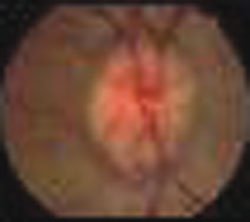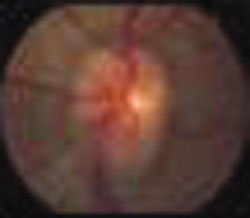Middle-aged man complains of transient vision loss
 Donald G. Bockin |
A 52-year-old man was referred from the emergency room complaining of minute-long episodes of transient vision loss for the past 4 months. He said his vision would go completely dark and then return. He also said he has had migraines every other day for the past 4 months; they were relieved by over-the-counter Excedrin Migraine (acetaminophen 250 mg/aspirin 250 mg/ caffeine 65 mg, Novartis) and have increased to a daily occurrence in the recent past. His last eye examination was 2 years earlier and had normal findings.
On physical exam by the emergency room, the patient’s vital signs were – temperature: 98° F, pulse: 72, respiration: 16, blood pressure: 152/91 mm Hg, weight: 233 lb, height: 71 inches, pain level: 0 and oxygen saturation: FIO2. On neurological consultation, head CT (noncontrast) and MRI were negative; the cavernous sinuses did not appear to have thromboses. Lab testing, including complete blood count, chemistry, erythrocyte sedimentation rate and liver function tests (LFTs or LFs, including liver enzymes), were normal.
|
|
|
|
The patient’s fundus photos from 2 years
earlier. Images: Bockin DG |
|
The patient’s past medical history included diabetes mellitus type 2, hypertension, chronic pancreatitis, folliculitis, obesity, carpal tunnel syndrome, cholelithiasis and external hemorrhoids. He had a cholecystectomy 10 years earlier and smokes 10 cigarettes a day for the last 6 months but denies ethyl alcohol and illegal drugs.
The patient’s medication included acetaminophen 500 mg/hydrocodone 10 mg four times a day; amlodipine besylate tablets 10 mg once daily; chewable aspirin tablets 81 mg once daily; clonidine patch 0.1 mg/24 h; enalapril maleate tablets 20 mg twice daily; hydrochlorothiazide tablets 25 mg once daily; metoprolol tartrate tablets 100 mg twice daily; Lantus (insulin glargine, Sanofi Aventis) 100 units/mL injectable 34 units subcutaneous every day for blood sugar; insulin Aspart human 100 units/mL injection (eight units subcutaneously before meals) for blood sugar; metformin HCl tablets 1,000 mg twice daily for diabetes; docusate calcium caplets 240 mg once daily to soften stool; gabapentin caplets 300 mg three times daily for seizure; hemorrhoid ointment twice daily; simvastatin tablets 20 mg once daily at bedtime for cholesterol; trazodone HCl tablets 100 mg at bedtime for sleep; and methocarbamol 300 mg twice daily as a muscle relaxant.
|
|
|
|
The dilated fundus exam showed the right eye
with 0.1 and 3+ disc edema and hyperemia in both eyes. |
|
|
|
|
|
Magnified view of the right and left
eyes. |
|
His best corrected visual acuity was 20/20 in each eye with a manifest refraction of +0.25 D OD and -0.50 D OD. Versions were smooth and full, and confrontation visual fields were full. Pupils were equal, round and reactive to light without afferent pupillary defect. His IOP was 10 mm Hg in the right eye and 11 mm Hg in the left eye. Examination of the anterior segment was unremarkable other than normal age changes. His color vision was 13/14 in the right eye and 14/14 in the left eye by Ishihara plates. His visual field testing showed a possible nasal step in both eyes.
Dilated fundus examination showed obscured cup-to-disc ratio in the right eye and possible 0.1 cup-to-disc ratio in the left. In addition, both eyes showed 3 to 4 disc edema in the right eye, 2 to 3 in the left eye and hyperemia in both eyes.
Additional testing of a temporal artery biopsy was performed for this patient and was negative.
|
|
|
|
The patient’s MRIs were
negative. |
|

What is your diagnosis?
The differential diagnosis includes fugax, cerebrovascular accident, complicated migraine, cavernous sinus thrombosis, giant cell arteritis and pseudotumor cerebri.
Idiopathic intracranial hypertension (IIH), sometimes called by the previous names benign intracranial hypertension or pseudotumor cerebri, is a neurological disorder that is characterized by increased intracranial pressure in the absence of a tumor or other diseases. The primary symptoms are headache (in 92% to 94% of cases), according to Binder and colleagues; nausea and vomiting; pulsatile tinnitus (in 64% to 87% of cases), according to Binder and colleagues and Sismanus; diplopia and other visual symptoms. If untreated, it may lead to swelling of the optic disc in the eye, which can progress to vision loss.
Various other symptoms, such as numbness of the extremities, generalized weakness, loss of smell and incoordination are reported more rarely; none are specific for IIH. In children, numerous nonspecific signs and symptoms may be present.
Incidence
On average, IIH occurs in about one per 100,000 people and can occur in children and adults. The median age at diagnosis is 30. IIH occurs predominantly in women, especially those between 20 and 45 years old, who are four to eight times more likely than men to be affected. Overweight and obesity strongly predispose a person to IIH. Women who are more than 10% over their ideal body weight are 13 times more likely to develop IIH, and this figure goes up to 19 times in women who are more than 20% over their ideal body weight. In men this relationship also exists, but the increase is only fivefold in those more than 20% above their ideal body weight. The incidence of IIH is strongly determined by sex and body weight, according to Binder and colleagues.
Despite several reports of IIH in families, there is no known genetic cause for IIH. People from all ethnicities are susceptible. In children, there is no difference in incidence between males and females.
IIH is diagnosed with a brain scan (to rule out other causes) and a lumbar puncture; lumbar puncture may also provide temporary and sometimes permanent relief from the symptoms. Some respond to medication, but others require surgery to relieve the pressure.
The increased intracranial pressure leads to compression and traction of the cranial nerves and can cause nerve palsies, the most common of which involves the sixth nerve. More rarely, the third and fourth nerves are affected. The seventh nerve is affected occasionally.
The increased pressure also leads to papilledema. This occurs in practically all cases of IIH, but not everyone experiences symptoms from this. Those who do report transient visual obscurations, episodes of difficulty seeing that occur in both eyes but not necessarily at the same time. Long-term untreated papilledema leads to visual loss, initially in the periphery but progressively towards the center of vision. If the papilledema has been longstanding, visual fields may be constricted and visual acuity may be decreased. Longstanding papilledema leads to optic atrophy.
Etiology
The mechanism of IIH remains unclear and is a diagnosis of exclusion. Therefore, IIH can only be diagnosed if there is no alternative explanation for the symptoms. Intracranial pressure may be increased due to medications such as high-dose vitamin A derivatives (e.g., isotretinoin for acne), long-term tetracycline antibiotics (for a variety of skin conditions) and hormonal contraceptives. There are numerous other diseases, mostly rare conditions, that may lead to intracranial hypertension.
Common secondary causes of intracranial hypertension include obstructive sleep apnea, systemic lupus erythematosis, chronic kidney disease and Behçet’s disease.
Diagnosis
The diagnosis may be suspected on the basis of the history and examination. To confirm the diagnosis, as well as excluding alternative causes, several tests are required. More in-depth testing may be performed if the history is not typical or the patient is more likely to have an alternative problem such as children, men, the elderly or women who are not overweight.
Neuroimaging, usually with CT or MRI, rules out mass lesions. In IIH these scans may be normal, although small or slit-like ventricles and “empty sella sign” (flattening of the pituitary gland caused by increased pressure) may be seen. An MR venogram is also performed in all cases or, according to Friedman and Jacobson, only in atypical cases to exclude the possibility of venous obstruction or cerebral venous sinus thrombosis.
Controlling symptoms
The first step in symptom control is draining the cerebrospinal fluid by lumbar puncture. If necessary, this may be performed at the same time as a “diagnostic” lumbar puncture. In some cases, this is sufficient to control the symptoms, and no further treatment is needed.
The procedure can be repeated if necessary, but this is generally taken as a cue that additional treatments may be required to control the symptoms and preserve vision. Repeated lumbar punctures are sometimes needed to control the intracranial pressure urgently if vision deteriorates rapidly.
The primary goal in treating IIH is preventing vision loss and blindness, as well as symptom control. IIH is primarily treated by reducing cerebrospinal fluid pressure and, where applicable, weight loss. IIH may resolve after initial treatment, may go into spontaneous remission or may continue chronically.
The best studied medical treatment is Diamox (acetazolamide, Duramed), which acts by inhibiting the enzyme carbonic anhydrase and reduces cerebrospinal fluid production by 6% to 57%. The diuretic, furosemide, is sometimes used if acetazolamide is not tolerated, but this has little effect on the intracranial pressure.
Various analgesics may be used in controlling the headache. In addition, a low dose of an antidepressant and anticonvulsants have some additional benefit. The use of steroids to reduce the intracranial pressure is controversial; they may be used in severe papilledema, but otherwise their use is discouraged.
Surgical treatments
Two primary surgical procedures exist for treating IIH. The first would be optic nerve sheath decompression and fenestration, and the other would be a shunt placed in the brain. Surgery would normally be offered only if medical therapy is either unsuccessful or not tolerated. In cases of severe obesity, gastric bypass surgery has been shown to lead to a marked improvement in symptoms.
According to Acheson, it is not known what percentage of people with IIH will remit spontaneously and what percentage will develop chronic disease.
IIH does not normally affect life expectancy. The major complications from IIH arise from untreated or treatment-resistant papilledema. In various case series, the long-term risk of one’s vision being significantly affected by IIH is reported to lie anywhere between 10% and 25%, according to Binder and colleagues and Acheson.
From national hospital admission databases it appears that the need for neurosurgical intervention for IIH has increased markedly over the period between 1988 and 2002. This has been attributed at least in part to the rising prevalence of obesity, although some of this increase may be explained by the increased popularity of shunting over optic nerve sheath fenestration.
Case report follow-up
The patient was evaluated by neurology and had lumbar puncture. Other than a high opening pressure and a large volume, it was normal. The patient’s repeat MRI was again normal. His current working diagnosis is pseudotumor cerebri. He was started on Diamox 250 mg twice daily.
On follow-up examination, the patient’s disc edema was about the same, possibly slightly better. The patient states his headaches are not as intense but not completely gone. His vision has returned to normal. He has a follow-up appointment in 3 months.
On a personal note, my neighbor was having issues with an abnormal gate. All of his examinations and testing were normal, including his vision and eyes. His neurologist then videotaped his walk, preformed a lumbar punch and then re-videoed his gate. His walk improved. He has since had a shunt place in his head and has had no significant issues since.
Both of these cases are different than the norm. Both are older males and not females in their mid-30s. With the aging population, this is a diagnosis to keep in mind.
References:
- Acheson JF. Idiopathic intracranial hypertension and visual function. Br Med Bull. 2006;79-80:233–244. doi:10.1093/bmb/ldl019.
- Binder DK, Horton JC, Lawton MT, McDermott MW. Idiopathic intracranial hypertension. Neurosurgery. 2004;54(3):538–551.
- Curry WT, Butler WE, Barker FG. Rapidly rising incidence of cerebrospinal fluid shunting procedures for idiopathic intracranial hypertension in the United States, 1988-2002. Neurosurgery. 2005;57(1):97–108.
- Dandy WE. Intracranial pressure without brain tumor – diagnosis and treatment. Ann Surg. 1937;106(4):492–513.
- Digre KB, Corbett JJ. Idiopathic intracranial hypertension (pseudotumor cerebri): A reappraisal. Neurologist. 2001;7: 2–67.
- Friedman DI, Jacobson DM. Diagnostic criteria for idiopathic intracranial hypertension. Neurology. 2002;59(10):1492–1495.
- Sismanis A. Pulsatile tinnitus. A 15-year experience. Am J Otol. 1998;19(4):472–427.
- Smith JL. Whence pseudotumor cerebri? J Clin Neuroophthalmol. 1985;5(1):55–56.
- Soler D, Cox T, Bullock P, Calver DM, Robinson RO. Diagnosis and management of benign intracranial hypertension. Arch Dis Child. 1998;78(1):89–94.
- Donald G. Bockin, OD, can be reached at Central Texas Veterans Health Care System, Temple, Texas; (254) 743-0733; bockin.donald@VA.gov.
- Edited by Leo P. Semes, OD, a professor of optometry, University of Alabama at Birmingham and a member of the Primary Care Optometry News Editorial Board. He may be reached at (205) 934-6773; fax: (205) 934-6758; lsemes@uab.edu.
- Disclosure: Dr. Bockin has no direct financial interest in any products mentioned, nor is he a paid consultant for any companies mentioned.











